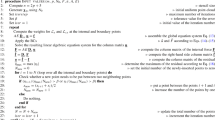Abstract
Combining the radial point interpolation method (RPIM), the dual reciprocity method (DRM) and the hybrid boundary node method (HBNM), a dual reciprocity hybrid radial boundary node method (DHRBNM) is proposed for linear elasticity. Compared to DHBNM, RPIM is exploited to replace the moving least square (MLS) in DHRBNM, and it gets rid of the deficiency of MLS approximation, in which shape functions lack the delta function property, the boundary condition can not be applied easily and directly and it’s computational expense is high. Besides, different approximate functions are discussed in DRM to get the interpolation property, in which the accuracy and efficiency for different basis functions are compared. Then RPIM is also applied in DRM to replace the conical function interpolation, which can greatly improve the accuracy of the present method. To demonstrate the effectiveness of the present method, DHBNM is applied for comparison, and some numerical examples of 2-D elasticity problems show that the present method is much more effective than DHBNM.
Similar content being viewed by others
References
Du, Y.X., Chen, L.P. and Luo, Z., Topology synthesis of geometrically nonlinear compliant mechanisms using meshless method. Acta Mechanica Solida Sinica, 2008, 21(1): 51–61.
Atluri, S.N. and Zhu, T., A new meshless local Petrow-Galerkin approach in computational mechanics. Computational mechanics, 1998, 22: 117–127.
Onate, E., Idelsohn, S., Zienkiewicz, O.C. and Taylor, R.L., A finite point method in computational mechanics. Applications to convective transport and fluid flow. International Journal for Numerical Methods in Engineering, 1996, 39(22): 3839–3866.
Liszka, T.J. and Duarte, C. and Tworzydlo, W.W., hp-meshless cloud method. Computer Methods in Applied Mechanics and Engineering, 1996, 139: 263–288.
Atluri, S.N., Sladek, J., Sladek, V. and Zhu, T., The local boundary integral equation and it’s meshless implementation for linear elasticity. Computational mechanics, 2000, 25: 180–198.
Mukherjee, Y.X. and Mukherjee, S., The boundary node method for potential problems. International Journal for Numerical Methods in Engineering, 1994, 140: 797–815.
Wang, J.G. and Liu, G.R., A point interpolation meshless method based on radial basis functions. International Journal for Numerical Methods in Engineering, 2002, 4: 1623–1648.
Xia, P., Long, S.Y. and Cui, H.X., Elastic dynamic analysis of moderately thick plate using meshless LRPIM. Acta Mechanica Solida Sinica, 2009, 22(2): 116–124.
Gu, Y.T. and Liu, G,R., A boundary radial point interpolation method (BRPIM) for 2-D structural analyses. Structural Engineering & Mechanics, 2002, 15: 535–550.
Hon, Y.C. and Chen, W., Boundary knot method for 2D and 3D Helmholtz and convection-diffusion problems under complicated geometry. International Journal for Numerical Methods in Engineering, 2003, 56(13): 1931–1948.
Chen, W., Meshfree boundary particle method applied to Helmholtz problems. Engineering Analysis with Boundary Elements, 2002, 26(7): 577–581.
Fu, Z., Chen, W. and Yang, W., Winkler plate bending problems by a truly boundary-only boundary particle method. Computational Mechanics, 2009, 44(6): 757–763.
Chen, W., Fu, Z. and Jin, B.T. A truly boundary-only meshfree method for inhomogeneous problems based on recursive composite multiple reciprocity technique. Engineering Analysis with Boundary Elements, 2010, 34(3): 196–205.
Lancaster, P. and Salkauskas, K., Surface generated by moving least squares methods. Mathematics of Computation, 1981, 37: 141–158.
Zhang, J.M., Yao, Z.H. and Li, H., A Hybrid boundary node method. International Journal for Numerical Methods in Engineering, 2002, 53: 751–63.
Zhang, J.M., Yao, Z.H. and Masataka, T., The meshless regular hybrid boundary node method for 2-D linear elasticity. Engineering Analysis with Boundary Elements, 2003, 127: 259–68.
Wang, H.T., Yao, Z.H. and Cen, S., A meshless singular hybrid boundary node method for 2-D elastostatics. Journal of the Chinese Institute of Engineers, 2004, 27: 481–490.
Miao, Y., Wang, Y.H. and Yu, F., An improved hybrid boundary node method in two-dimensional solids. Acta Mechanica Solida Sinica, 2005, 18(4): 307–315.
Nardini, D. and Brebbia, C.A., Boundary integral formulation of mass matrices for dynamic analysis. In: Topics in Boundary Element Research, Vol. 2, Springer-Verlag, Berlin and New York, 1985.
Yan, F., Wang, Y.H., Tham, L.G. and Cheung, Y.K., Dual reciprocity hybrid boundary node method for 2-D elasticity with body force. Engineering Analysis with Boundary Elements, 2008, 32(9): 713–725.
Yan, F., Wang, Y.H. and Miao, Y. et al., Dual reciprocity hybrid boundary node method for free vibration analysis. Journal Sound and Vibration, 2009, 321(3–5): 1036–1057.
Yan, F., Wang, Y.H., Miao, Y. and Tan, F., Dual reciprocity hybrid boundary node method for three-dimensional elasticity with body force. Acta Mechanica Solida Sinica, 2008, 21(3): 267–277.
Yan, F., Miao, Y. and Yang, Q.N., Quasilinear hybrid boundary node method for solving nonlinear problems. CMES-Computer Modeling in Engineering & Science, 2009, 46(1): 541–552.
Li, X.L., Zhu, J.L. and Zhang, S.G., A hybrid radial boundary node method based on radial basis point interpolation. Engineering Analysis with Boundary Elements, 2009, 33(11): 1273–1283.
Wang, F.Z., Chen, W. and Jiang, X.R., Investigation of regularized techniques for boundary knot method. Communication in Numerical Methods in Engineering, 2009, DOI: 10.1002/cnm. 1275.
Partridge, P.W. and Sensale, B., Hybrid approximation functions in the dual reciprocity boundary element method. Communications in Numerical Methods in Engineering, 1997, 13: 83–94.
Neves, A.C. and Brebbia, C.A., The multiple reciprocity boundary element method in elasticity: A new approach for transforming domain integrals to the boundary. International Journal for Numerical Methods in Engineering, 1991, 31: 709–727.
Glauceny, C.M., Paul, W.P. and Jorge, O.B., The method of fundamental solutions with dual reciprocity for some problems in elasticity. Engineering Analysis with Boundary Elements, 2004, 28: 453–461.
Author information
Authors and Affiliations
Corresponding author
Additional information
Project supported by the National Basic Research Program of China (No. 2010CB732006), the CAS/SAFEA International Partnership Program for Creative Research Teams (No. KZCX2-YW-T12) and the National Natural Science Foundation of China (No. 11002154).
Rights and permissions
About this article
Cite this article
Yan, F., Feng, X. & Zhou, H. Meshless Method of Dual Reciprocity Hybrid Radial Boundary Node Method for Elasticity. Acta Mech. Solida Sin. 23, 447–458 (2010). https://doi.org/10.1016/S0894-9166(10)60047-X
Received:
Revised:
Published:
Issue Date:
DOI: https://doi.org/10.1016/S0894-9166(10)60047-X




